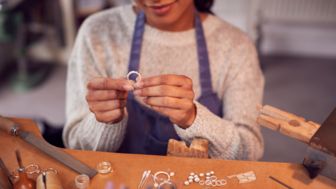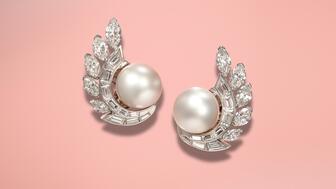The entrepreneur and “Shark Tank” star will share his top tips for success.
5 Consumer Trends to Look Out for Post-COVID-19
A Bain & Co. report on the luxury sector outlines post-pandemic retail trends, from new online shopping habits to a louder call for sustainability.

New York—While few sectors have been spared by the COVID-19 pandemic, the luxury sector has been hit especially hard.
Global luxury sales are expected to fall 25 to 30 percent year-over-year in the first quarter of 2020, according to a recent report by Bain & Company.
The report, “Luxury after Covid-19: Changed for (the) Good?,” takes a look at the current state of the market and what it will look like after the pandemic has passed.
Here are five consumer trends to look out for going forward.
The rebound will reach China first.
Luxury shopping will likely see a rebound in China first, granted the virus stays controlled.
The Chinese market may already be on its way to recovery, said Bain in its report.
Asia as a whole saw “a significant sales decline, with China at the forefront of the negative trend,” in the early part of 2020.
Nearly every luxury brand had to temporarily close or reduce its store hours, leading to double-digit year-over-year sales declines, but there is a light ahead that may spark hope in the rest of the world.
As luxury stores begin to reopen in China, consumers are heading back faster than expected, said Bain.
China is a key luxury market with its consumers representing 35 percent of the global personal luxury goods market and accounting for 90 percent of global luxury market growth in 2019.
In addition, travel restrictions will translate to purchases being made in China that may have otherwise been made abroad.
The shift to more online shopping will accelerate.
The rise of online shopping is old news, but the way consumers have made use of online shopping services during the pandemic may cement into habits, said the report.
Looking at grocery shopping as an example, a Business Insider survey found that 42 percent of respondents who bought groceries online or for pickup in the last few weeks had not done so before.
As more consumers become aware of the options available to them via online shopping, the demand for the services are likely to increase.
"There are folks that would never have thought about buying online who are now habituated to it,” said Instacart president Nilam Ganenthiran in a recent interview with Credit Suisse.
The rise in demand has been putting a strain on e-tailers across sectors and consumers have been complaining about long wait times.
Brands that put the time into improving services, focusing on product assortment, user experience and digital marketing may see
The report advised luxury brands to “invest more in online sales and marketing, particularly in areas hit hardest by the pandemic.”
How much shopping will remain online post-pandemic remains a subject of debate in retail.
While Bain is forecasting a rise in shopping shifting to e-commerce channels, Peter Smith wrote in his last column that consumers will be eager to return to stores and that retailers should be ready for them.
The call for eco-friendly and socially conscious brands will only get louder.
Sustainability has been a buzzword in the retail space in recent years, with more consumers eschewing fast-fashion and disposable products for more sustainable alternatives.
Brands will want to be mindful of consumer concerns post-pandemic when thinking about end-to-end product life cycle, supply chain management, and how to dispose of unsold stock, said Bain.
In the fine jewelry world, consumers have been doing their homework on environmental and social issues, turning to conscious brands that use recycled metals and responsibly sourced gemstones, for example.
Greenwich St. Jewelers in New York City recently stocked the 10-piece “Lift Collection,” featuring jewelry showcasing gemstones from Anza Gems, purchased for fair trade prices directly from dealers in Tanzania and Kenya.
All proceeds from the collection went to nonprofit Gem Legacy, which funds projects benefiting East African mining communities, and the Tanzanian Women Miners Association.
A brand’s ethics and aesthetics will be weighed equally.
Consumers are not simply mindful of purchasing eco-friendly and ethical products, they will soon be prioritizing these items, according to the Bain report.
Described as the “rise of a post-aspirational mindset,” the report suggests that shoppers will be on the lookout for “purposeful brands.”
RELATED CONTENT--Designer’s Diary: My Journey to ‘Sustainable’ JewelryDeloitte echoed this point in its Global Powers of Luxury Goods 2019 survey, noting that younger, affluent shoppers are socially and environmentally conscious and hold luxury brands to high standards, particularly in regard to sustainable and ethical production processes.
The survey pointed to Tiffany & Co. as an example of a luxury goods company appealing to these customers, highlighting its responsible sourcing as well as its social and environmental work, particularly its philanthropic foundations focusing on reef conservation and awareness for responsible mining.
The company was one of the first jewelers to use gold sourced from the “Salmon Gold” initiative, which aims to mine gold in a way that’s mindful of the habitats of salmon and other fish.
Inclusion will be key as spending power is reduced.
Luxury brands tread a fine line between aspirational and exclusionary.
As unemployment numbers grow, consumer sentiment will take a dive. The U.S. consumer confidence index sank in April to 86.9 points from a revised 118.8 in March, its lowest level since 2014.
“Brands will need to use all their ingenuity to revamp their offer at accessible price points, reflecting the reduced spending power of many middle-class customers,” said the report.
Bain & Co. concluded its report on a positive note, stating that luxury will regain its strength once the situation stabilizes.
“Lessons in resilience learned in the dark days of 2020 can power a sustainable recovery in 2021 and beyond. This crisis may be transforming the luxury industry for good, but it could also be a transformation for the good.”
The Latest

The Ukrainian brand’s new pendant is modeled after a traditional paska, a pastry often baked for Easter in Eastern European cultures.

The jeweler has announced a grand reopening for its recently remodeled location in Peoria, Illinois.

Interior designer Athena Calderone looked to decor from the 1920s and 1930s when crafting her first fine jewelry collection.


During a call about its full-year results, CEO Efraim Grinberg discussed how the company is approaching the uncertainty surrounding tariffs.

The free program provides educational content for jewelry salespeople and enthusiasts to learn or refresh their diamond knowledge.

Bench jewelers spend years honing their skills, Jewelers of America’s Certification validates their talents.

The feedback will be used to prepare other jewelers for the challenges ahead, the organization said.

The online sessions are designed to teach jewelers to use AI tools like ChatGPT and Claude to grow their business.

The opening marks the jewelry retailer’s first location in the Midwest.

The “United in Love” collection offers tangible mementos of hearts entwined with traditional and non-traditional commitment heirlooms.

Robert Goodman Jewelers will hold a “Black Jewelry Designers and Makers” event on April 27.

Editor-in-Chief Michelle Graff answers questions about how the new taxes levied on countries like India and China will impact the industry.

Kenewendo, Botswana’s minster of minerals and energy, discusses closing the deal with De Beers and the work that was missed along the way.

The historic fancy vivid blue diamond set to headline Christie’s Geneva sale next month could sell for up to $50 million.

LVMH CFO Cécile Cabanis also discussed the effects of tariffs so far.

The “Mad Men” and “The Morning Show” star steals jewelry, art, and handbags from his wealthy neighbors in “Your Friends & Neighbors.”

The organization has reelected Kalpesh Jhaveri as president.

An investigation found that the former managing director of Movado’s Dubai branch overstated and prematurely recorded sales.

The collection pays tribute to the Japanese philosophy of Ma, studying balance, stillness, and the interplay between presence and absence.

Mari Lou’s Fine Jewelry in Orland Park, a suburb of Chicago, is closing its doors.

GIA’s labs in Dubai and Hong Kong are now accepting larger diamonds in light of the “logistical challenges” presented by the new tariffs.

These earrings by Van Cleef & Arpels, featuring the same design as a pair worn by Princess Grace, are up for auction at Woolley & Wallis.

Two experts share how artificial intelligence tools can help retailers run a more efficient business.

Kentaro Nishimura, who has been with the pearl company since 1997, has been promoted to president and CEO of Mikimoto America.

“America Telling Time: 150 Years of Bulova” explores the storied history of the American watchmaker.



























